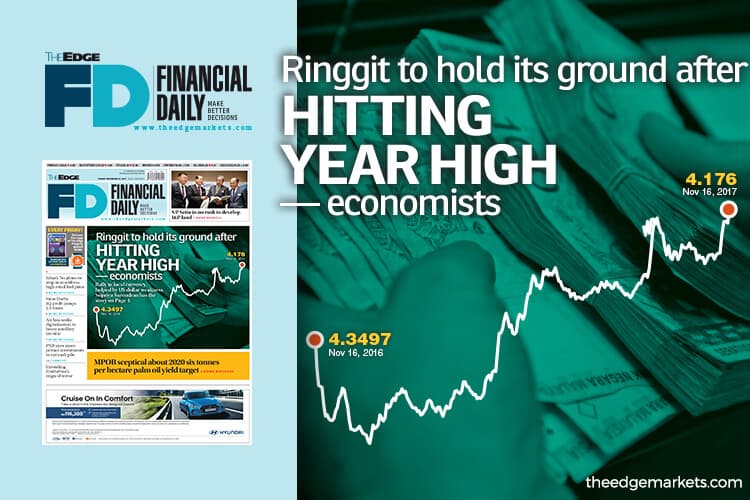
This article first appeared in The Edge Financial Daily on November 17, 2017
KUALA LUMPUR: The ringgit, which touched a one-year high of 4.1745 against the US dollar on Wednesday, is expected to remain strong on encouraging domestic and external factors, say economists.
RHB Research Institute Sdn Bhd said the ringgit’s strength was partly due to the weaker US dollar, on the back of the uncertainty of the US Republican party’s tax bill.
“This may be also due to the hawkish statement by Bank Negara Malaysia (BNM) from its monetary policy statement on Nov 8 and expectations of a wider current account surplus recorded in the third quarter of 2017 (3Q17),” RHB Research said in a note yesterday.
“Looking forward, we expect the ringgit to recover gradually over time as the Malaysian economy is expected to grow at a sustained pace,” it added.
At the Monetary Policy Meeting on Nov 9, BNM maintained the overnight policy rate (OPR) at 3%. BNM said in a statement that “given the strength of the global and domestic macroeconomic conditions, the monetary policy committee may consider reviewing the current degree of monetary accommodation to ensure the sustainability of the growth prospects of the Malaysian economy.”
Since the statement was released, the ringgit has appreciated by as much as 0.7% from 4.2065 on Nov 9.
AffinHwang Investment Bank Bhd chief economist Alan Tan told The Edge Financial Daily that the ringgit’s strength is expected to continue on a combination of both strong domestic and external factors.
“The ringgit’s performance is in line with our earlier expectations of the ringgit strengthening to 4.10 against the US dollar by the end of the year,” said Tan. “On the domestic front, given the statement made by BNM, I believe the expectation is for the central bank to raise the OPR sooner rather than later.”
Tan also expects Malaysia’s 3Q17 gross domestic product to come in at 6% and for the full-year gross domestic product (GDP) growth to be at the upper end of the official forecast of 5.7%, judging by the positive economic fundamentals.
“On top of that, the [US] dollar’s weakness has stemmed from economists’ expectations that the effect from [US President] Donald Trump’s policy, in particular his tax reforms, would only be felt in the later part of 2018 going into 2019. ... With that in mind, the [US] dollar’s strength which many expected failed to materialise,” he said.
Tan said Trump’s appointment of Jerome Powell to replace Janet Yellen as the chair of the US Federal Reserve (Fed) also sent a message that the Fed would continue with an “easy” monetary policy and gradual interest rate hike.
“Earlier, people were expecting John Taylor, who has a more hawkish stance to monetary policy, to take over as Fed chair, which means the market would read it as him raising interest rates more than what was guided and the [US] dollar could see some strengthening.
“Powell, on the other hand, is perceived as someone who will continue to follow Yellen’s guidance on a gradual increase in interest rates, and all this has continued to strengthen the ringgit compared to the [US] dollar,” said Tan.
MIDF Amanah Investment Bank Bhd chief economist Dr Kamaruddin Md Nor said that he is cautiously optimistic about the near-term direction of the ringgit.
“I think the ringgit’s performance is driven by BNM’s statement as well as feel-good macroenomic indicators, with consensus expecting a better 3Q GDP growth at 5.7%,” Kamaruddin told The Edge Financial Daily.
“Also, we have seen a recent rally in terms of Brent crude oil, and historically this has a positive co-relation with the ringgit and being an exporter of crude oil, Malaysia tends to benefit,” he said.
He added that uncertainty over the proposed tax overhaul in the US also weighed on the greenback and was positive on the ringgit.
Brent crude oil futures rose to a high of US$64.27 per barrel on Nov 6, a 13% increase from US$56.82 on Dec 30 last year, amid supply cuts by major exporters and the political tension in Saudi Arabia.